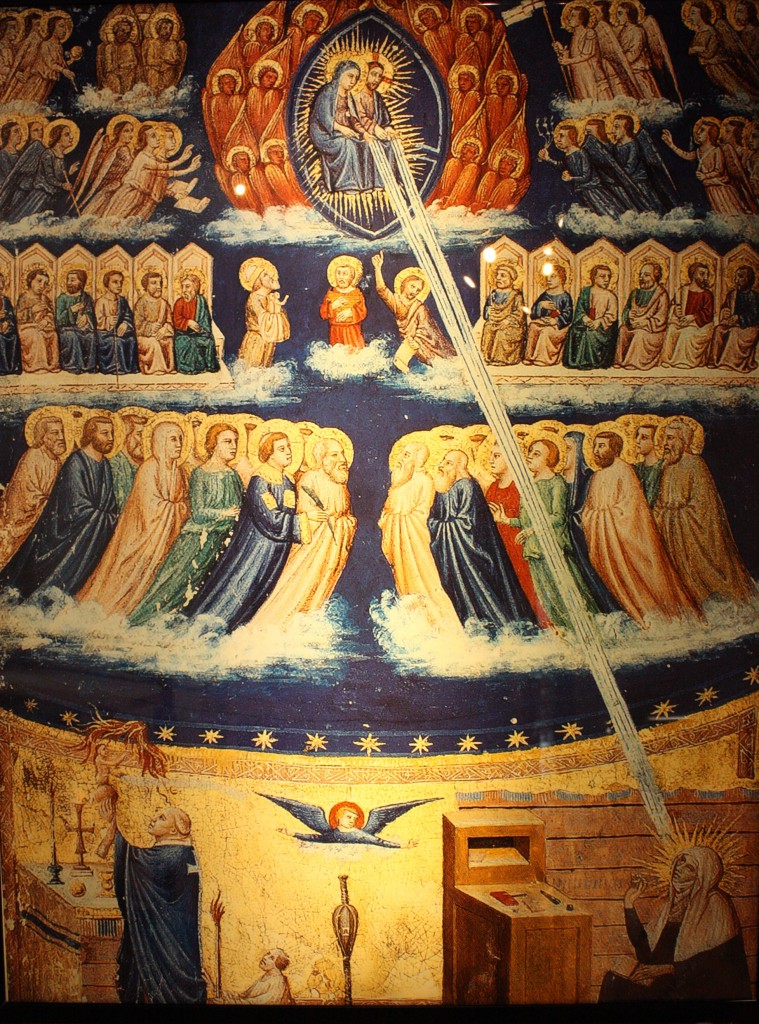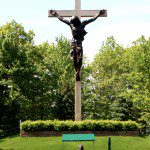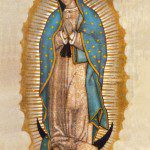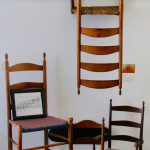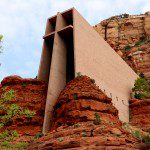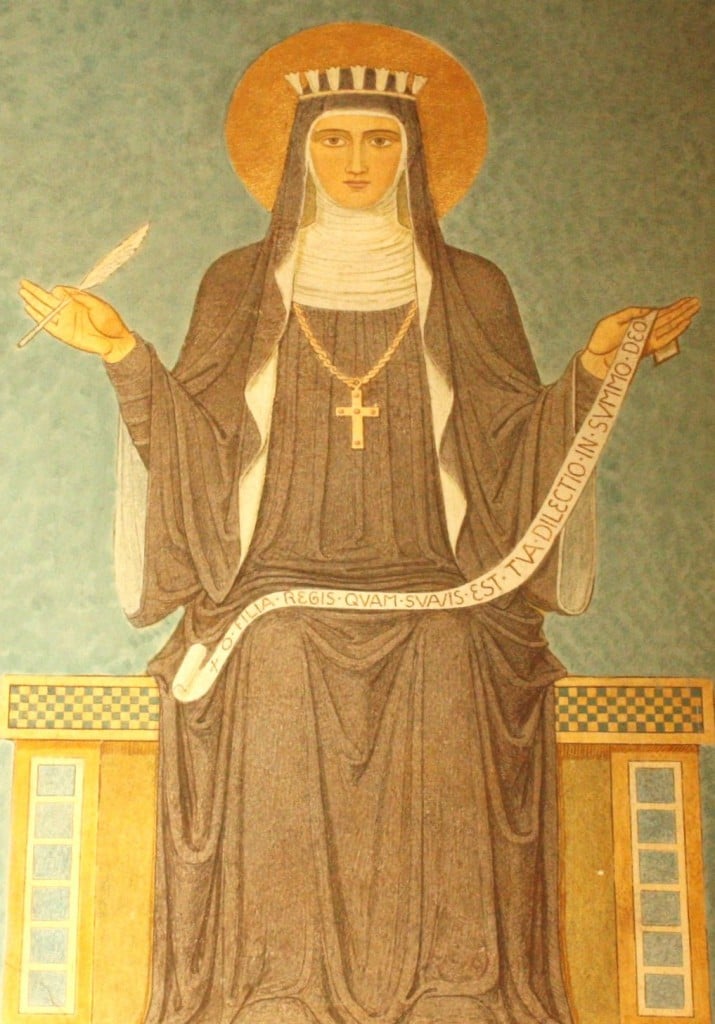
Today we come to Bingen, Germany, home to one of the most remarkable women in history. If Hildegard of Bingen had a resume (unusual for a 12th-century mystic, I admit, but humor me) it would have been many pages long. She was an abbess, healer, writer, musician, visionary, counselor, preacher, linguist, naturalist, poet and an adviser to kings, bishops and princes. She wrote more than 70 liturgical songs, the first sung play, and books on theology, medicine, diet and natural history. All the while she kept up a voluminous correspondence with people in and out of the church, leading one scholar to dub her the “Dear Abby of the 12th century.”
If I could invite a handful of people from history for dinner at my house, Hildegard would be among them—though I suspect she would likely dominate the conversation so much that the other guests would be intimidated.
So when my son Carl decided to study in Belgium and I looked at a map and found that Bingen was a short train ride away, I was delighted (one indication of my enthusiasm for Hildegard is that I visited her before Carl).
As I wrote in my post On the Romantic Rhine, Bingen is located at the southern end of one of the most scenic stretches of the Rhine River. Hildegard’s life was tied to this beautiful valley–in fact, she was called “The Sybil of the Rhine” by later generations of admirers. Thus if you’re doing a Hildegard Tour, there’s no better way to arrive in Bingen than by boat from the north, for a slow journey through the gorgeous countryside helps explain Hildegard’s love for the natural world and her view of creation as holy.
If you’ve ever been tempted to complain about your childhood (and admit it—you have), consider the life of Hildegard. Born in 1098 as the tenth of ten children of a noble family, she was dedicated to the church by her parents at the tender age of eight, though she didn’t formally enter religious life until she was fourteen. As a young woman she went to live with her older cousin Jutta in a nun’s hermitage attached to a male Benedictine monastery at Disibodenberg.
Jutta seems to have been a pretty stern and ascetic sort, and one wonders how a bright spirit like Hildegard fared in such a constrained (at least by contemporary standards) atmosphere. The two lived quiet lives shaped by the rhythms of prayer, liturgy and Biblical study. While Hildegard didn’t have a formal education, the Benedictines had great respect for learning and she received instruction in natural history as well as religious matters, learning a rough-and-ready Latin that served her well in her later writings.
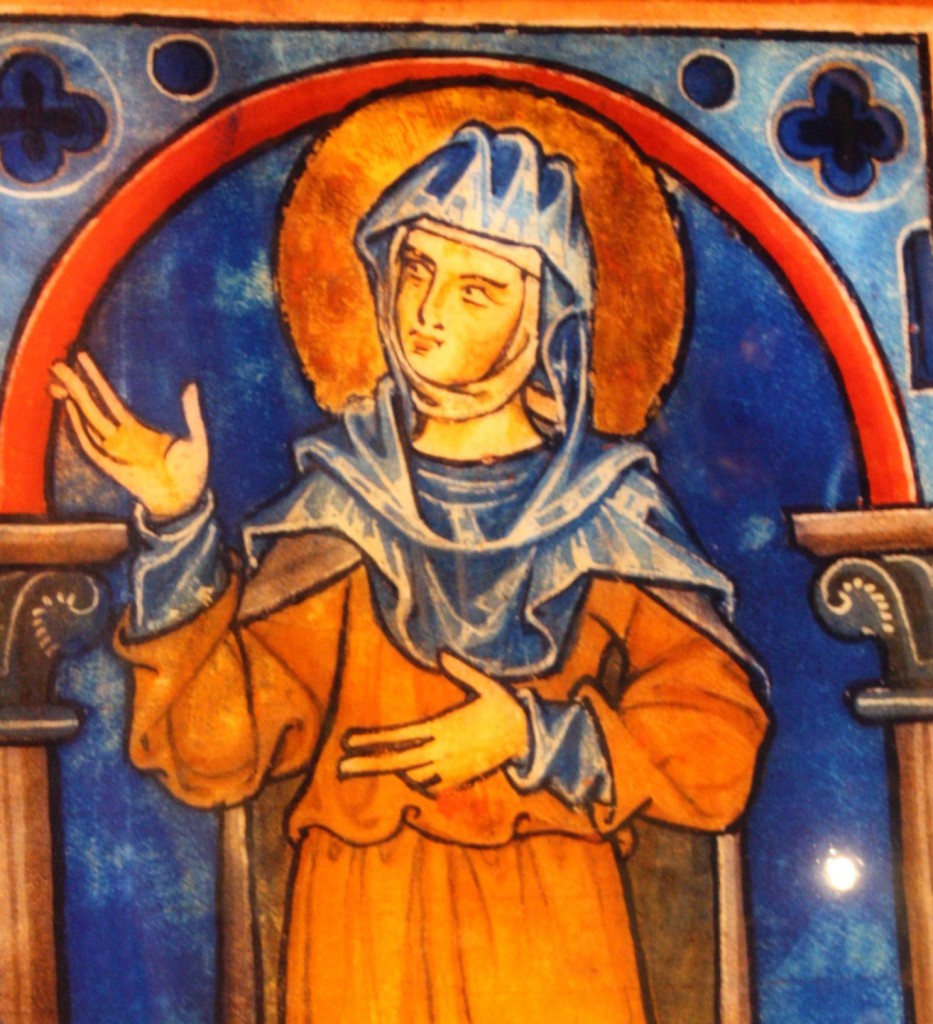
Hildegard grew into a most unusual woman, brilliant, charismatic and interested in a wide range of subjects that went far beyond the cloister. She was also sickly, suffering from periodic fevers, pain and fatigue. And she had a secret unknown to virtually everyone: she had been seeing extraordinary mystical visions from the time she was three.
At the age of 42, Hildegard’s quiet life changed forever when she received a divine command to share her visions with the world. “I am merely a too-sensitive, frail rib with mystical lungs, who saw a living, blazing fire that couldn’t be put out,” she wrote. “This Light said to me, ‘Shame-filled, earth-shod woman—untaught and unlettered—remember you’ve been illuminated by My light. It ignites in you an inner sun, burning with divine mysteries and secrets. Don’t be timid. Tell these. Although you’re hesitant to speak out, don’t be. Speak of the Fire this vision has shown you.’”
By this time Hildegard was the abbess of a small community of nuns that had formed at Disibodenberg. She spent the next ten years writing Scivias, a theological work that attempts to explain the fiery images she had received. With characteristic Hildegard chutzpah, she sent a draft of the manuscript to one of the most prominent religious figures of the day, Bernard of Clairvaux. He in turn sent it to Pope Eugene III. And while popes throughout history have gotten many things wrong (i.e., Galileo), this pope got it right. He declared Hildegard’s visions to be divinely inspired, and from that point on the obscure German nun was launched into public life, gradually gaining fame and influence in both the religious and political realms.
At the age of 49, Hildegard founded her first abbey at Bingen, taking 18 nuns with her over the objections of the monks at Disibodenberg (Hildegard took to her bed when they refused her request, and then experienced a miraculous recovery when they relented). That abbey was destroyed long ago, but after visiting Bingen I can see why she would choose to relocate there. While Disibodenberg was in the hinterlands, Bingen was on the Rhine, the busiest travel route through Europe. While Hildegard was a nun, she also clearly liked to be where the action was.
During an age when women rarely lived into their 50s, Hildegard seemed to grow more creative and productive with each passing year. After she completed her first book, she launched into a second and then a third book of theology. She composed songs for her nuns to sing, taking the standard plain chant of the day and turbo-charging it, greatly expanding its vocal range to create soaring melodies that one historian has described as the equivalent of Gothic cathedrals in music. She wrote books on medicine and natural history and corresponded with monks and nuns on spiritual matters and with royalty about political concerns. She was both deeply mystical and deeply practical, a rare combination in any age.
At the age of 60, Hildegard went on the first of four preaching tours, speaking in marketplaces because at the time women were prohibited from speaking in churches. At the age of 67 she founded a second abbey on the other side of the Rhine because her own community had grown too large, crossing the river by boat twice a week to oversee it. And as if all of this indefatigable energy and creativity wasn’t enough, she even created her own language, a secret code that was discovered after her death. (Honestly, the more I learn about Hildegard the more I feel that I have totally wasted my life.) When she died at the age of 81, I bet they kept checking her body to make sure she didn’t leap up for yet one more endeavor.
So there’s a brief introduction to the amazing Hildegard, who intrigues the modern world as much as she did her contemporaries. Let me leave you with her own self-description:
“There was once a king sitting on his throne. Around him stood great and wonderfully beautiful columns ornamented with ivory, bearing the banners of the king with great honor. Then it pleased the king to raise a small feather from the ground, and he commanded it to fly. The feather flew, not because of anything in itself but because the air bore it along. Thus am I, a feather on the breath of God.”
